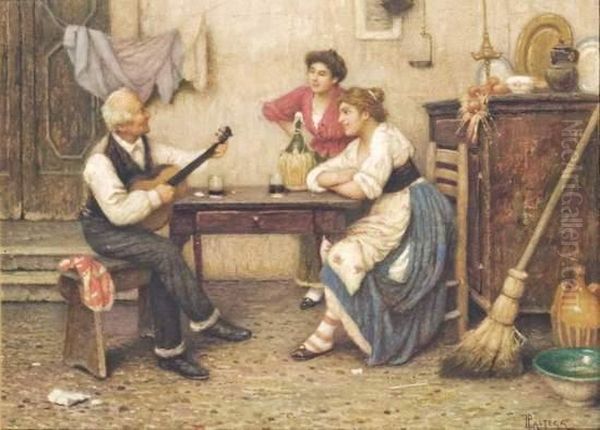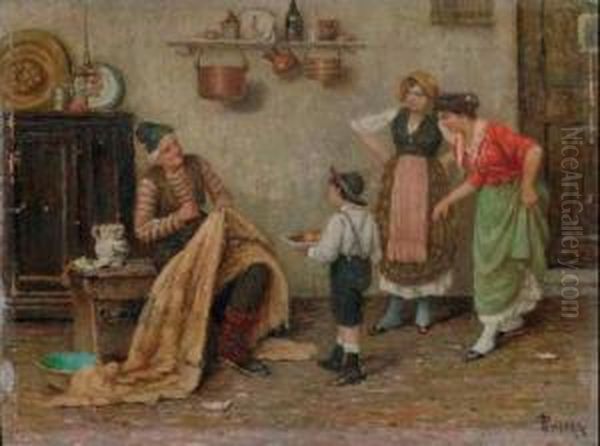Luigi Pastega, an Italian painter born in 1858 and passing in 1927, carved a distinct niche for himself within the vibrant tapestry of late 19th and early 20th-century Italian art. His legacy is primarily built upon his evocative oil paintings that meticulously captured the nuances of everyday life, particularly within the enchanting city of Venice. Through his canvases, Pastega offered an intimate glimpse into the world of ordinary Venetians, their activities, and the unique atmosphere of their lagoon city, distinguishing himself as a keen observer and a skilled practitioner of genre painting.
Early Life and Artistic Formation in Venice
Luigi Pastega's journey into the art world began in Piano di Sorrento, a picturesque town in Southern Italy, where he was born in 1858. However, it was in Venice that his artistic sensibilities were truly nurtured and honed. He enrolled as a student at the prestigious All'Accademia di Belle Arti di Venezia (Venice Academy of Fine Arts), a venerable institution that had shaped generations of artists. During his formative years at the Academy, Pastega studied under notable figures such as P. M. Molmenti and N. Nan, and was also a student of Guilio Greganti's courses.
While these instructors provided a foundational academic training, it was the influence of Giacomo Favretto (1849-1887) that proved most decisive in shaping Pastega's artistic direction. Favretto, himself a celebrated painter of Venetian life, was a professor at the Academy and a leading figure in the Venetian school of genre painting. Pastega became deeply absorbed in Favretto's approach, which emphasized the depiction of popular Venetian life, its characters, and its unique settings with a blend of realism, charm, and anecdotal detail. This focus on genre scenes, particularly those rooted in the Venetian experience, became the hallmark of Pastega's own artistic career.
The Essence of Pastega's Art: Venetian Genre Scenes

Luigi Pastega dedicated his artistic endeavors to capturing the spirit and daily rhythms of Venice. His preferred medium was oil on canvas, which allowed him to build up rich textures and convey the interplay of light and color that is so characteristic of the city. His style can be broadly categorized as Realism, though imbued with a warmth and affection for his subjects that transcended mere photographic representation. He was less concerned with grand historical or mythological themes and more fascinated by the unpretentious beauty of ordinary existence.
His canvases often depict bustling market squares, quiet canals, intimate domestic interiors, and the playful antics of children. He possessed a keen eye for detail, meticulously rendering the textures of fabrics, the expressions on faces, and the specificities of Venetian architecture and ambiance. Following in the footsteps of Favretto, Pastega excelled in creating narrative vignettes, scenes that told a small story or captured a fleeting moment, inviting the viewer to step into the world he portrayed. His works are characterized by their precise drawing, balanced compositions, and a sensitive use of color that evokes the particular light of Venice.
Signature Compositions and Thematic Focus
Several of Luigi Pastega's works have gained recognition and serve as excellent examples of his artistic preoccupations. Among his notable paintings is "Playtime" (often also referred to by its Italian titles, "Gioco infantile" or "L'altalena"). This work, typical of his interest in childhood, likely captures the innocence and joy of children engaged in simple games, perhaps in a sun-dappled Venetian courtyard or campo. Such scenes allowed Pastega to explore themes of youth, community, and the timeless nature of everyday pleasures.
Another significant piece is "The Fish Seller" ("Il venditore di pesce"). This painting would have depicted a common sight in Venice, a city intrinsically linked to the sea and its bounty. Through such a work, Pastega could explore character and social dynamics, portraying the vendor, their wares, and perhaps the interactions with customers. These market scenes were rich opportunities for capturing local color and the vibrant, unscripted life of the city.
"The Courtship" ("Il corteggiamento") suggests a focus on human relationships and social customs. This theme, popular among genre painters, allowed for the depiction of subtle emotional exchanges and narrative storytelling within a familiar setting. Whether a shy encounter or a more overt romantic gesture, such a painting would delve into the personal lives and traditions of the Venetian people.

The painting titled "Concertino Domestico" (Domestic Concert or Little Home Concert) further illustrates Pastega's interest in intimate, indoor scenes. This work likely portrays a family or a group of friends gathered for a musical interlude, highlighting the importance of domestic life and shared cultural activities. The careful rendering of the interior, the figures, and their engagement with the music would be central to its charm. Similarly, works broadly titled "Scena di genere" (Genre Scene) underscore his consistent dedication to this category of painting, showcasing various aspects of Venetian life.
A Canvas of Contemporaries: The Italian Art Scene
Luigi Pastega was active during a dynamic period in Italian art, a time when artists were exploring various stylistic paths, from the lingering influences of Romanticism and Academicism to the burgeoning movements of Realism, Impressionism, and Divisionism. Understanding Pastega's work benefits from considering the broader artistic landscape of his time, populated by numerous talented individuals.
One of the most celebrated Italian artists of this era was Giovanni Boldini (1842-1931). Though primarily based in Paris, Boldini was renowned for his flamboyant portraits of high society figures, characterized by their dazzling brushwork and sense of movement. While stylistically different from Pastega's more grounded genre scenes, Boldini represents the international success some Italian artists achieved.
Angelo Morbelli (1853-1919) was a key figure in Italian Divisionism, a technique involving the application of paint in small dots or strokes of pure color. Morbelli often depicted social themes, particularly the lives of the elderly and the poor, with a poignant sensitivity, offering a different facet of Realism compared to Pastega's often more cheerful scenes.
Fausto Zonaro (1854-1929) was another contemporary who, like Pastega, engaged with genre painting. However, Zonaro became particularly famous for his Orientalist scenes and later served as the court painter to the Ottoman Sultan in Constantinople. His work demonstrates the diverse thematic interests pursued by Italian painters of the period.
Giacomo Toma (1836-1883), active slightly earlier but whose influence extended, was a prominent figure in Neapolitan Realism. His paintings often depicted somber domestic scenes and social issues with a profound sense of empathy, contributing to the broader realist current in Italian art.
Plinio Nomellini (1866-1943) was another leading proponent of Divisionism in Italy. His work is characterized by vibrant colors and often explored landscapes, allegorical themes, and scenes of labor, reflecting a more overtly modern and sometimes symbolic approach.
Vincenzo Caprile (1856-1936), a Neapolitan painter, was known for his lively depictions of street scenes, coastal views, and genre subjects, sharing with Pastega an interest in capturing the vivacity of local life, albeit in a different regional context.
Francesco Gioli (1846-1922) was associated with the Macchiaioli, a group of Italian painters who were precursors to Impressionism, emphasizing painting outdoors and capturing the effects of light and shadow through "macchie" (patches or spots) of color. Gioli focused on Tuscan landscapes and scenes of rural life.
Giovanni Fattori (1825-1908), a leading figure of the Macchiaioli, was renowned for his depictions of military life, battle scenes, and Tuscan landscapes. His commitment to realism and direct observation had a significant impact on Italian art.
Closer to Pastega's Venetian context was Ettore Tito (1859-1941). A highly successful contemporary, Tito was also a professor at the Venice Academy and known for his vibrant, light-filled paintings of Venetian life, society portraits, and beach scenes. His work often possessed a more cosmopolitan and decorative flair than Pastega's.
Guglielmo Ciardi (1842-1917), along with his sons Beppe and Emma, was a prominent Venetian landscape painter. Ciardi was celebrated for his atmospheric views of the Venetian lagoon and countryside, capturing the unique interplay of light, water, and sky, a context that also informed Pastega's depictions of the city.
Alessandro Milesi (1856-1945) was another Venetian painter who, like Pastega and Favretto, specialized in portraits and genre scenes. His work often depicted the everyday lives of Venetians with warmth and realism, making him a close artistic relative of Pastega.
Telemaco Signorini (1835-1901), another key member of the Macchiaioli, was known for his keen observations of social life and his often critical depictions of urban and rural scenes, bringing a sharp intellectual edge to his realism.
Antonio Mancini (1852-1930) developed a highly individualistic style of realism, characterized by its expressive brushwork and thick impasto. He was particularly acclaimed for his portraits, often of working-class subjects and performers.
These artists, among many others, formed the rich and varied artistic milieu in which Luigi Pastega worked. While some pursued grander themes or more avant-garde styles, Pastega remained steadfast in his commitment to the intimate and authentic portrayal of Venetian genre scenes, contributing his unique voice to the chorus of Italian art.
Exhibitions, Recognition, and Enduring Presence
While detailed records of Luigi Pastega's participation in major lifetime exhibitions are not extensively documented in readily available sources, his work has maintained a presence in the art market, indicating a sustained appreciation for his particular skills and subjects. His paintings, such as "Concertino Domestico" and "Scena di genere," have appeared in auction catalogs, including those specializing in "Dipinti del XIX secolo" (19th Century Paintings). For instance, "Concertino Domestico" was noted in a 2016 auction with an estimated value, demonstrating that his works continue to be collected and valued.
The appearance of an artist's work in auctions decades after their passing speaks to an enduring interest. For painters like Pastega, whose focus was on specific regional culture and everyday life, this interest often stems from both the artistic merit of the works and their value as historical and cultural documents. They offer a window into a bygone era, rendered with skill and affection.
Legacy of a Venetian Storyteller
Luigi Pastega's contribution to Italian art lies in his dedicated and skillful portrayal of Venetian life. He was not an innovator in the sense of pioneering new artistic movements, but rather a master of his chosen genre, following in the rich tradition of Venetian narrative painting. His work is a testament to the beauty and interest found in the ordinary, and his canvases serve as charming and insightful records of the people, customs, and atmosphere of Venice during his time.
He successfully captured the intimate moments and public spectacles of the city, from the laughter of children at play to the bustling commerce of its markets and the quietude of its domestic spaces. Influenced by his teacher Giacomo Favretto, Pastega developed a style that was both realistic in its detail and warm in its sentiment. As an art historian, one appreciates Pastega for his consistent vision, his technical proficiency in oil painting, and his ability to convey the unique character of Venice. His paintings remain a delightful and valuable part of Italy's artistic heritage, offering enduring glimpses into the heart of Venetian life at the turn of the 20th century.